Navy leading powers at the beginning of World War I
In 1897, the German Navy was significantly inferior to the British fleet. The British were 57 armadillos I, II, III, class, Germans 14 (4 ratio: 1), the British 15 battleships coastal defense, the Germans 8, the British 18 armored cruisers, the Germans 4 (4,5 ratio: 1), the British 125 class 1-3 cruisers, the Germans 32 (4: 1), the Germans were inferior in other combat units.
Arms race
The British wanted not only to maintain the advantage, but also to increase it. In 1889, the parliament passed a law according to which more funds were allocated for the development of the fleet. At the heart of London’s naval policy was the principle that the British Navy should have surpassed the two fleets of the most powerful maritime powers.
Berlin initially did not pay much attention to the development of the fleet and the seizure of colonies, Chancellor Bismarck did not see much point in this, considering that the main efforts should be directed at European policy and the development of the army. But under Emperor Wilhelm II, priorities were revised, Germany began to fight for the colonies and the construction of a powerful fleet. In March 1898, the Reichstag passed the "Fleet Law", which provided for a sharp increase in the Navy. For 6 years (1898-1903's) planned to build 11 squadron battleships, 5 armored cruisers, 17 armored cruisers and 63 destroyer. The shipbuilding programs of Germany were subsequently constantly adjusted upwards - 1900, 1906, 1908, 1912. According to the 1912 law, the number of fleets planned to bring to the 41 battleship, 20 armored cruisers, 40 light cruisers, 144 destroyers, 72 submarines. Particular attention was paid to battleships: in the period from 1908 to 1912 in Germany, the 4 battleship was laid annually (in previous years, two each).
In London, believed that the naval efforts of Germany pose a great threat to the strategic interests of Britain. England intensified the naval arms race. The task was to have 60% more battleships than the Germans. From 1905, the British began to build battleships of the new type - "dreadnoughts" (after the name of the first ship of this class). They differed from the squadron battleships in that they had stronger armaments, were better armored, with a more powerful propulsion unit, a larger displacement, etc.
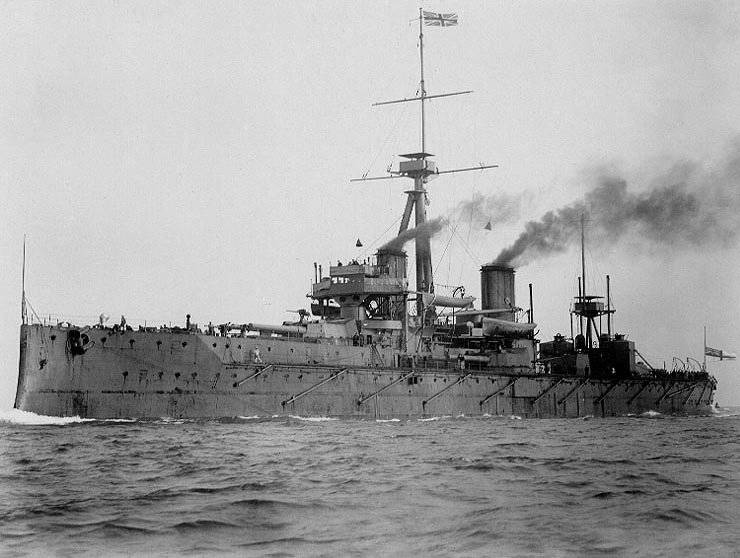
Battleship Dreadnought.
Germany responded by building its dreadnoughts. Already in 1908, the British had 8 dreadnoughts, and the Germans had 7 (some were in the process of being completed). The ratio of "dodrednouet" (squadron battleships) was in favor of Britain: 51 versus German 24. In 1909, London decided to build two of its own on every German dreadnought.
The British tried to preserve their naval power through diplomacy. At the 1907 Hague Peace Conference of the Year, they proposed to limit the scope of construction of new warships. But the Germans, believing that this step would be beneficial only to Britain, rejected this proposal. The naval arms race between England and Germany continued until the First World War. To its top, Germany firmly took the position of the second naval power, overtaking Russia and France.
Other great powers - France, Russia, Italy, Austria-Hungary, etc., also tried to build up their naval armaments, but for a number of reasons, including financial problems, they could not achieve such impressive successes.
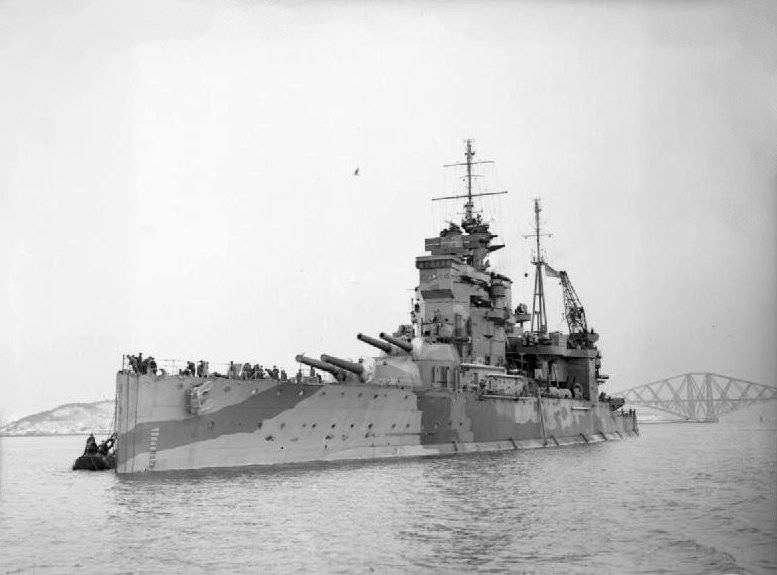
"Queen Elizabeth" - the lead ship of the super dreadnoughts series Queen Elizabeth.
Fleet value
The fleets were supposed to perform a number of important tasks. First, to protect the coasts of countries, their ports, important cities (for example, the main purpose of the Russian Baltic Fleet is to protect St. Petersburg). Secondly, the fight against enemy naval forces, the support of their ground forces from the sea. Thirdly, the protection of maritime communications, strategic points, especially for Britain and France, they owned huge colonial empires. Fourthly, to ensure the status of the country, a powerful navy showed the position of the state in the world informal table of ranks.
The basis of the then naval strategy and tactics was linear combat. In theory, the two fleets were to line up and find out in the artillery duel who the winner was. Therefore, the basis of the fleet were squadron battleships and armored cruisers, and then dreadnoughts (from 1912-1913's and superdreadnoughts) and battle cruisers. The battlecruisers had weaker reservations, artillery, but were faster and had a longer range. Armadillo squadrons (battleships of the pre-dreadnought type), the armored cruisers were not written off, but they were brought to the background, ceasing to be the main striking force. Light cruisers were supposed to carry out raids on enemy naval communications. Destroyers and destroyers were intended for torpedo attacks, destruction of enemy transports. Their combat vitality was based on speed, maneuverability and secrecy. The Navy also included special-purpose ships: minelayers (installed sea mines), minesweepers (making passages in minefields), transports for seaplanes (hydro-cruisers), etc. The role of the submarine fleet constantly increased.
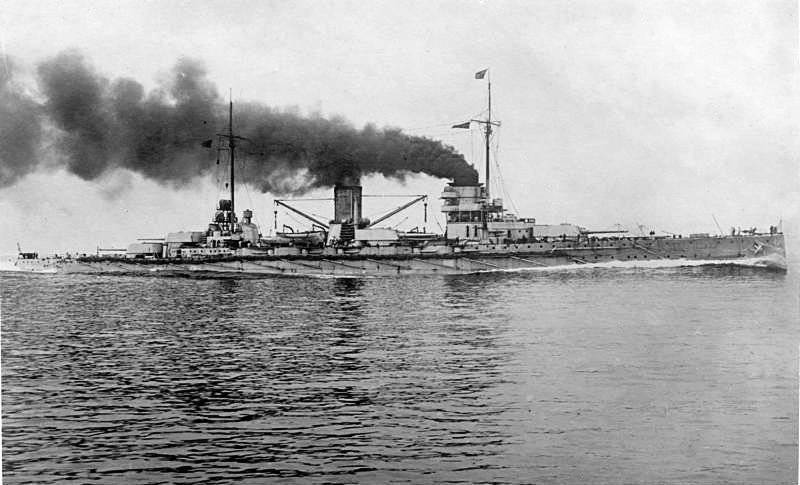
Cruiser "Goeben"
United Kingdom
The British at the beginning of the war had 20 dreadnought, 9 battleships, 45 old battleships, 25 armored vehicles and 83 light cruisers, 289 destroyers and destroyers, 76 submarines (most of them were outdated, they could not operate in the open sea). I must say that, despite the power of the British fleet, its leadership was distinguished by great conservatism. New items hardly found their way (especially not related to the linear fleet). Vice-Admiral Philip Colomb, a naval theorist and historian, author of the book “Sea War, Its Basic Principles and Experience” (1891 year), said: “There is nothing that would show that history maritime warfare laws have changed in some way. " The admiral justified the theory of "possession of the sea" as the basis of the imperial policy of Britain. He believed that the only way to achieve victory in the war at sea is to create complete supremacy in the naval forces and destroy the enemy's navy in one general battle.
When Admiral Percy Scott suggested that “the era of the dreadnoughts and superdreadnaughts has ended irrevocably” and advised the Admiralty to focus on development efforts aviation and the submarine fleet, its innovative ideas were sharply criticized.
The general leadership of the fleet was carried out by the Admiralty, led by W. Churchill and the first sea lord (chief of the naval headquarters) Prince Ludwig Battenberg. British ships were based in the harbors of Humberg, Scarborough, Firth of Fort and Scapa Flow. In 1904, the Admiralty considered the relocation of the main forces of the Navy from the English Channel region to the north, to Scotland. This decision brought the fleet out of the threat of a narrow strait blockade by the growing German Navy, and allowed it to quickly control the entire North Sea. According to the English maritime doctrine, which Battenberg and Bridgman developed shortly before the war, the basing of the main fleet forces in Scapa Flow (a harbor in Scotland on the Orkney Islands), outside the effective range of the German submarine fleet, should have led to the blockade of the main forces of the German fleet, which and happened during the First World War.
When the war began, the British were in no hurry to thrust themselves to the German shores, fearing the blows of submarines and the bearing forces. Major hostilities unfolded on land. The British confined themselves to covering communications, protecting the coast and blockading Germany from the sea. The British fleet was ready to join the battle if the Germans brought their main fleet into the open sea.
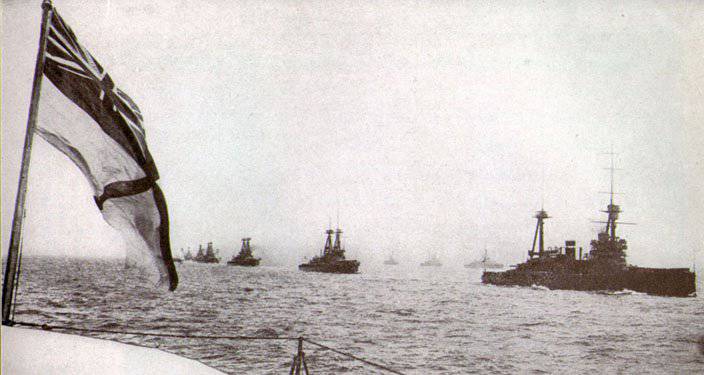
British "Big Fleet".
Germany
The German Navy had 15 dreadnought, 4 battlecruisers, 22 old battleships, 7 armored ships and 43 light cruisers, 219 destroyers and destroyers, 28 submarines. For some indicators, for example, in speed, the German ships were better than the British. On the technical innovations in Germany paid much more attention than in England. Berlin did not have time to complete its naval program, it was supposed to be completed in 1917 year. Although the German naval leaders were rather conservative, for example, Admiral Tirpitz initially thought that he was fond of building submarines "frivolously." A dominance of the sea is determined by the number of battleships. Only when he realized that the war would begin before the completion of the linear fleet construction program, he became a supporter of unlimited submarine warfare and the accelerated development of the submarine fleet.
The German Open Sea Fleet (Hochseeflotte), based in Wilhelmshaven, was to destroy the main forces of the British fleet (Grand Fleet, the Big Fleet) in open battle. In addition, the naval bases were in Kiel, Fr. Helgoland, Danzig. The Russian and French naval forces were not perceived as worthy opponents. The German Open Sea Fleet posed a constant threat to Britain and forced the English Grand Fleet to constantly be in the North Sea area in full combat readiness throughout the war, despite the lack of battleships in other theaters of war. Due to the fact that the Germans were inferior in the number of battleships, the German Navy tried to avoid open clashes with the Grand Fleet and preferred the strategy of raids into the North Sea, trying to lure some of the British fleet, cut it off from the main forces and destroy. In addition, the Germans focused on conducting an unrestricted submarine warfare to weaken the British Navy and lift the naval blockade.
The factor of the lack of autocracy affected the combat effectiveness of the German Navy. The main creator of the fleet was the grand admiral Alfred von Tirpitz (1849 - 1930). He was the author of the "risk theory", it was argued that if the German fleet compares with the English in strength, the British will avoid conflicts with the German Empire, because in the event of war, the German Navy will have a chance to inflict sufficient damage to the Grand Fleet for the loss by the British fleet of dominance at sea. With the beginning of the war, the role of the grand admiral fell. Tirpitz became responsible for building new ships and supplying the fleet. The “open sea fleet” was led by Admiral Friedrich von Ingenol (in 1913 — 1915 years), then Hugo von Pohl (from February 1915 of the year to January of 1916, before that he was Chief of the General Naval Staff), Reinhard Scheer (1916-1918). In addition, the fleet was the favorite brainchild of the German Emperor Wilhelm, if he trusted the decision to make generals to the army, the Navy managed it himself. Wilhelm did not dare to risk the fleet in an open battle and allowed to wage only a “small war” - with the help of submarines, destroyers, and mine settings. Line fleet had to adhere to a defensive strategy.
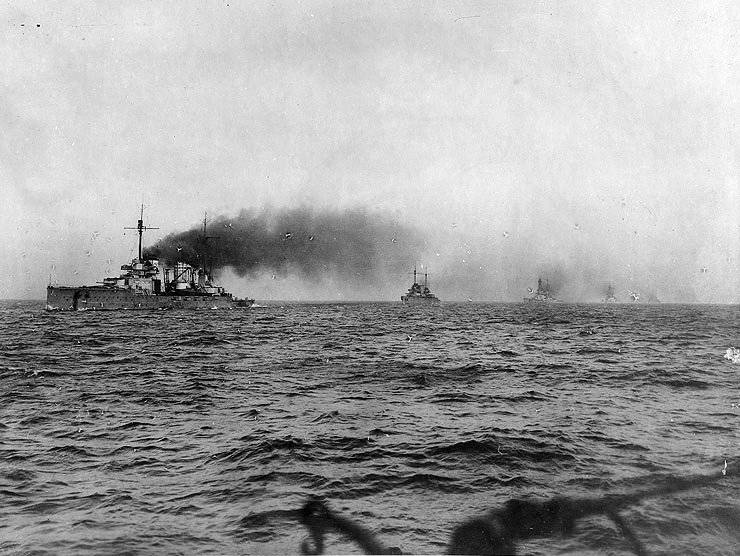
German "Open Sea Fleet"
France. Austria-Hungary
The French had 3 dreadnought, 20 battleships of the old type (battleships), 18 armored ships and 6 light cruisers, 98 destroyers, 38 submarines. In Paris, they decided to focus on the "Mediterranean Front", since the British agreed to defend the Atlantic coast of France. Thus, the French saved expensive ships, since there was no big threat in the Mediterranean - the Ottoman Navy was very weak and connected by the Russian Black Sea Fleet, Italy was neutral at first, and then went over to the side of the Entente, the Austro-Hungarian fleet chose the passive strategy. In addition, there was a fairly strong British squadron in the Mediterranean.
The Austro-Hungarian Empire had a 3 dreadnought (4 was launched in 1915 year), 9 battleships, 2 armored and 10 light cruisers, 69 destroyers and 9 submarines. Vienna also chose a passive strategy and "defended the Adriatic", the Austro-Hungarian fleet stood in Trieste, Split, Pula for most of the war.
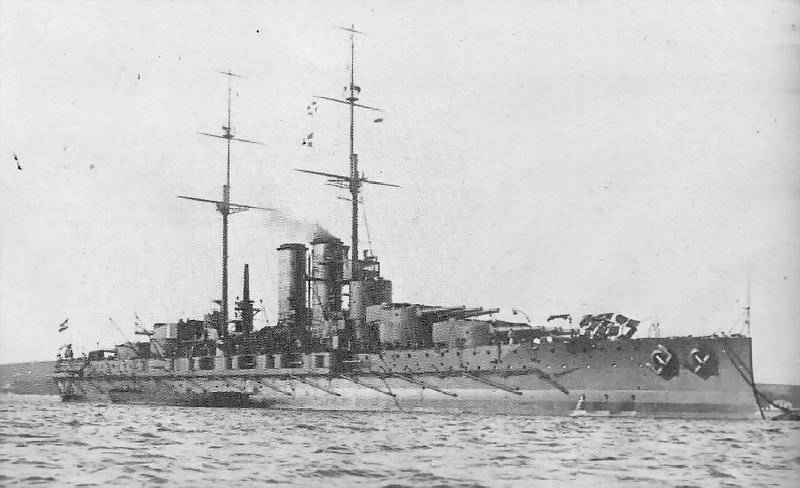
"Tegethof" in the prewar years. Austro-Hungarian battleship type Viribus Unitis.
Russia
The Russian fleet under Emperor Alexander III was second only to the naval forces of England and France, but then lost this position. The Russian Navy received an especially big blow during the Russo-Japanese War: almost the entire Pacific squadron and the best ships of the Baltic Fleet sent to the Far East were lost. The fleet was necessary to recover. During the period from 1905 to 1914, several naval programs were developed. They envisaged the completion of 4 battleships previously laid down, 4 armored cruisers and the construction of 8 new battleships, 4 linear and 10 light cruisers, 67 destroyers and 36 submarines. But by the beginning of the war, no program had been fully implemented (the State Duma, which did not support these projects, also played its role in this).
By the beginning of the war, Russia had 9 old battleships, 8 armored ships and 14 light cruisers, 115 destroyers and destroyers, 28 submarines (much of the old types). Already during the war, the 4 dreadnought type “Sevastopol” entered the Baltic Sea, all of them were laid in the 1909 year - “Sevastopol”, “Poltava”, “Petropavlovsk”, “Gangut”; on the Black Sea - 3 dreadnought type "Empress Maria" (laid in 1911 year).
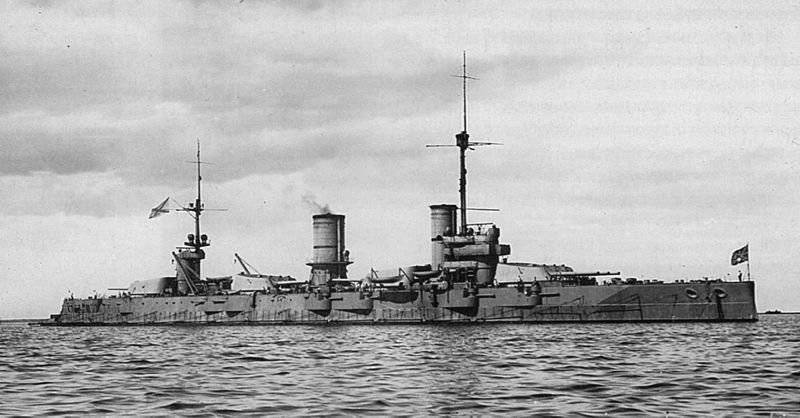
"Poltava" during the First World War.
The Russian Empire was not a backward power in the naval area. In some areas even lead. In Russia, excellent destroyers of the Novik type were developed. The ship to the beginning of the First World War was the best destroyer in its class, and served as a world model for the creation of destroyers of the military and postwar generation. Technical conditions for it were created in the Marine Technical Committee under the leadership of prominent Russian shipbuilding scientists A. N. Krylov, I. G. Bubnov and G. F. Schlesinger. The project was developed in the 1908-1909 years, the shipbuilding department of the Putilov factory, which was headed by engineers D. D. Dubitsky (mechanical part) and B. O. Vasilevsky (shipbuilding part). In the Russian shipyards, in the 1911 — 1916 years, in the 6-ti typical projects, a total of 53 ships of this class were laid. The destroyers combined the qualities of a destroyer and a light cruiser - speed, maneuverability and quite strong artillery weapons (4-e 102-mm gun).
Russian railway engineer Mikhail Petrovich Naletov was the first to embody the idea of a submarine with anchor mines. Already in the 1904 year, during the Russo-Japanese War, participating in the heroic defense of Port Arthur, Naleytov built his own submarine with a displacement of 25 tons, capable of carrying four mines. Conducted the first tests, but after the surrender of the fortress apparatus was destroyed. In 1909 — 1912, a submarine was built at the Nikolaev shipyard, dubbed the “Crab”. She became part of the Black Sea Fleet. During the First World War, "Crab" made several combat exits with mine settings, even reached the Bosphorus.
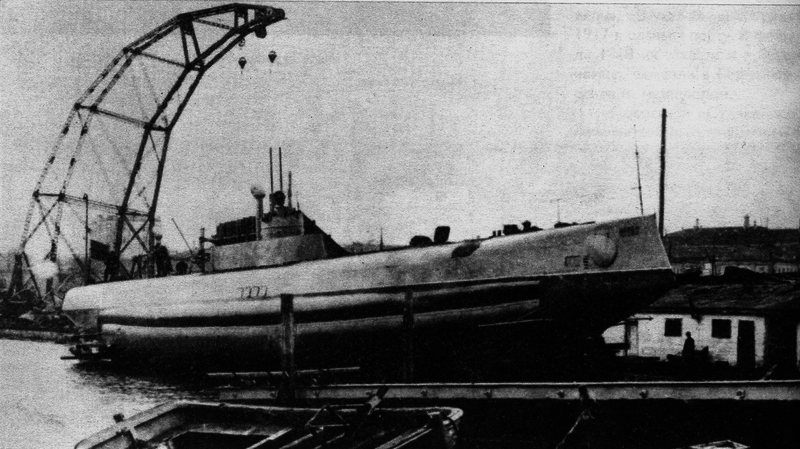
The world's first underwater mine layer - the submarine "Crab" (Russia, 1912 year).
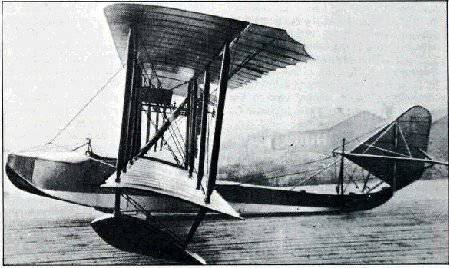 Already in the course of the war, Russia became the world leader in the use of hydro-cruisers (aircraft carriers), thanks to which the factor of domination in the field of creation and use of naval aviation contributed. Russian aircraft designer Dmitry Pavlovich Grigorovich, he worked as a technical director of the plant of the First Russian Aeronautical Society from 1912, in 1913 he designed the world's first seaplane (M-1) and immediately began to improve the aircraft. In 1914, Grigorovich built the flying boat M-5. It was a double biplane wooden structure. The seaplane entered service with the Russian fleet as a scout and spotter of the artillery fire, and in the spring of 1915, the plane made its first combat departure. In 1916, the new aircraft of Grigorovich, the heavier M-9 (naval bomber), was put into service. Then the Russian nugget designed the world's first seaplane fighter M-11.
Already in the course of the war, Russia became the world leader in the use of hydro-cruisers (aircraft carriers), thanks to which the factor of domination in the field of creation and use of naval aviation contributed. Russian aircraft designer Dmitry Pavlovich Grigorovich, he worked as a technical director of the plant of the First Russian Aeronautical Society from 1912, in 1913 he designed the world's first seaplane (M-1) and immediately began to improve the aircraft. In 1914, Grigorovich built the flying boat M-5. It was a double biplane wooden structure. The seaplane entered service with the Russian fleet as a scout and spotter of the artillery fire, and in the spring of 1915, the plane made its first combat departure. In 1916, the new aircraft of Grigorovich, the heavier M-9 (naval bomber), was put into service. Then the Russian nugget designed the world's first seaplane fighter M-11.On the Russian Dreadnought type "Sevastopol" for the first time applied the installation system is not two-and three-gun turrets of the main caliber. In England and Germany, they were initially skeptical of the idea, but the Americans appreciated the idea and the Nevada type battleships were built with three-turrets.
In the 1912 year, the 4 battle cruisers of the "Izmail" type were laid. They were intended for the Baltic Fleet. These would be the most powerful battlecruisers in the world for artillery weapons. Unfortunately, they were never completed. In the 1913 — 1914, eight Svetlana-type light cruisers were laid, four each for the Baltic and Black Sea fleets. They were going to be put into operation in 1915-1916 years, but did not have time. Russian submarines of the Bars type were considered among the best in the world (they began to be built from 1912 onwards). Total built 24 "Barca": 18 for the Baltic Fleet and 6 for the Black Sea.
It should be noted that in the Western European fleets in the prewar years paid little attention to the submarine fleet. This is due to two main reasons. First, the previous wars have not yet revealed their combat significance, only in World War I did their great importance become clear. Secondly, the then dominant naval doctrine of the “open sea” assigned submarine forces one of the last places in the struggle for the sea. The rule of the seas should have been won by battleships, having won the decisive battle.
Russian engineers and naval gunners made a great contribution to the development of artillery weapons. Before the war, Russian factories mastered the production of improved samples of naval guns caliber 356, 305, 130 and 100 mm. The manufacture of three-turrets began. In 1914, the engineer of the Putilov factory F. F. Lender and the artilleryman V.V. Tarnovsky became pioneers in the field of creating a special anti-aircraft gun with a caliber in 76 mm.
In the Russian Empire, three new torpedoes (1908, 1910, 1912) were developed before the war. They exceeded the same-type torpedoes of foreign fleets in speed, range, although they had a smaller total weight and charge weight. Before the war, multitubular torpedo tubes were created — the first such apparatus was built at the Putilov factory in 1913. He provided a volley fire with a fan, the Russian sailors mastered it before the start of the war.
Russia was a leader in the field of mine business. In the Russian Empire, after the war with Japan, two special minelayers, Amur and Yenisei, were built, and the construction of special minesweepers of the “Zapal” type began. In the West, before the start of the war, no attention was paid to the need to create special ships for launching and trawling sea mines. This is proved by the fact that in 1914, the British were forced to buy a thousand ball mines from Russia to protect their naval bases. The Americans bought not only samples of all Russian mines, but also trawls, considering them to be the best in the world, and invited Russian specialists to train them in the mine business. Americans and seaplanes Mi-5, Mi-6 bought. Before the beginning of the war in Russia, galvanic impact and shock-mechanical mines of the 1908 and 1912 samples were developed. In 1913, a floating mine (P-13) was constructed. She was kept submerged at a certain depth due to the action of an electric swimming device. Mines of previous models were kept at a depth due to buoys, which did not give much stability, especially during storms. P-13 had an electric shock fuse, a charge in 100 kg of tola and could stay at a given depth for three days. In addition, Russian experts have created the world's first river mine "Rybka" ("P").
In 1911, the fleet was armed with undercutting kite and cutter trawls. Their use shortened the timeframes of sweeping operations, since the mines that were hit and undermined were immediately destroyed. Earlier mines had to be towed to shallow water and destroyed there.
The Russian fleet was the cradle of radio. Radio has become a means of communication and control in battle. In addition, before the war, Russian radio engineers designed radio direction finders, which made it possible to use the device for reconnaissance.
Considering the fact that the new battleships on the Baltic did not enter service, moreover, the Germans had complete superiority in the forces of the line fleet, the Russian command adhered to a defensive strategy. The Baltic Fleet was to protect the capital of the empire. Mine defenses were the basis of naval defense — during the war years, 39 thousand of mines were laid at the mouth of the Gulf of Finland. In addition, on the coast and the islands were powerful batteries. Under their cover, cruisers, destroyers and submarines made raids. The battleships were to meet the German fleet if it tried to break through the minefields.
By the beginning of the war, the Black Sea Fleet was the master of the Black Sea, since the Turkish Navy had only a few relatively combat-ready ships - the 2 of the old battleships of the battleship, the 2 armored cruisers, the 8 destroyers. Attempts by the Turks before the war to change the situation by buying new ships abroad did not bring success. With the beginning of the war, the Russian command planned to completely block the Bosphorus and the Turkish coast, to support the troops of the Caucasian front (and, if necessary, the Romanian) from the sea. The question of carrying out a landing operation in the area of the Bosphorus, to capture Istanbul-Constantinople, was also considered. The situation was somewhat changed by the arrival of the newest battlecruiser “Goeben” and the light Breslau. ” The cruiser “Goeben” was more powerful than any old Russian battleship of the old type, but together the squadron battleships of the Black Sea Fleet would have destroyed it, therefore, in a collision with the entire squadron, “Goeben” retreated using its high speed. In general, especially after the commissioning of the dreadnoughts of the "Empress Maria" type, the Black Sea Fleet controlled the Black Sea basin - supported the troops of the Caucasian Front, destroyed Turkish transports, and attacked the enemy coast.
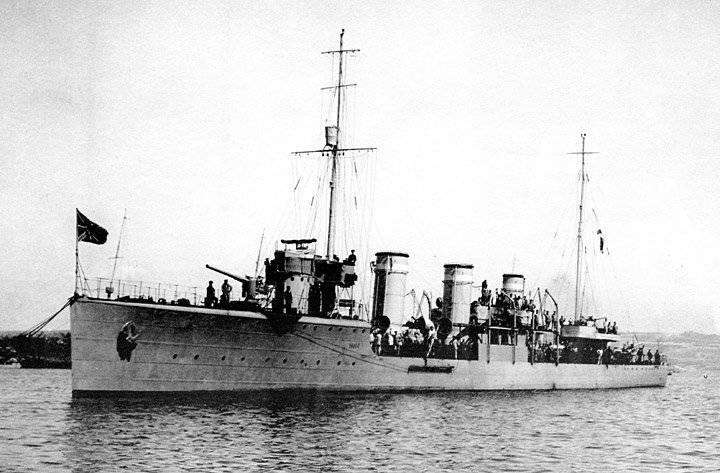
Destroyer type "Novik" ("Ardent").
Information